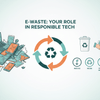What is e-waste and what can we do about it?

Introduction
Electronic devices are now a part of daily life. People use laptops, phones, and smartwatches every single day for work, communication, and fitness. But many do not think about what happens when these devices stop working or when we upgrade them for new models. This leads to a growing problem called electronic waste, also known as e-waste. E-waste is increasing around the world, and it harms the environment, human health, and natural resources. In this blog, we explain what e-waste is, why it is dangerous, how laptops, phones, and watches contribute to it, and what we can do to reduce it.
What Is E-Waste?
E-waste stands for electronic waste. It refers to any electronic device that is no longer useful, broken, outdated, or unwanted. When we throw away a laptop, phone, smartwatch, charger, or battery, it becomes e-waste. E-waste contains many materials, such as plastics, metals, wires, circuits, and sometimes even toxic elements. These materials can cause harm if they are not handled properly.
E-waste comes from many sources:
-
Old laptops that no longer run smoothly
-
Broken mobile phones with cracked screens or battery issues
-
Damaged smartwatches that no longer connect or charge
-
Electronic accessories like chargers, headphones, and cables
The amount of e-waste is rising every year because people replace their electronics more often. Companies release new models frequently, and many users upgrade even when their old device is still working. This behavior creates enormous waste piles that the planet cannot absorb safely.
Why Is E-Waste a Big Problem?
E-waste is a serious global issue for several reasons.
a) Toxic chemicals
Many electronics contain harmful substances such as lead, mercury, cadmium, and lithium. When e-waste is dumped in landfills, these chemicals leak into soil, air, and water. This pollution can cause health problems such as breathing issues, nerve damage, and skin diseases.
b) Environmental pollution
E-waste is often burned in open dumps. Burning plastic releases poisonous smoke that affects both people and wildlife. Polluted water from dumpsites can harm plants and animals.
c) Wasted resources
Laptops, phones, and smartwatches contain valuable materials like gold, silver, copper, aluminum, and rare earth metals. When we throw them away, these precious materials are lost forever. Recycling can recover these materials, but most people do not recycle properly.
d) Growing mountains of waste
Because people buy new devices regularly, landfills are filling up. The world creates millions of tons of e-waste every year, and only a small percentage is recycled safely. This makes e-waste one of the fastest-growing waste streams on the planet.
How Laptops Contribute to E-Waste
Laptops are used for work, study, entertainment, and communication. However, laptops also create a large amount of e-waste because they become slow or outdated quickly.
Here are key reasons laptops contribute to e-waste:
-
Short lifespan due to heavy use and heat damage
-
Non-replaceable batteries in many modern designs
-
Users upgrading frequently for better performance
-
Breakdowns in screens, keyboards, and internal components
When a laptop is thrown away, it adds heavy metals, plastics, and lithium batteries to the environment. These materials require proper recycling because they can cause serious harm if dumped.
How Mobile Phones Add to the E-Waste Crisis
Phones are replaced more often than laptops. Most users buy a new phone every 2–3 years. This makes mobile phones one of the biggest contributors to global e-waste.
Reasons include:
-
Faster upgrade cycles due to new models
-
Battery problems after long use
-
Software updates that slow down old phones
-
Hardware damage like broken screens
Phones contain valuable metals like gold and copper. But many people throw them away instead of recycling them. This leads to a massive loss of natural resources.
Smartwatches and Wearables: A New Source of E-Waste
Smartwatches are becoming more popular, but they also contribute to e-waste. These devices have small batteries, delicate sensors, and complex chips. They stop working after a few years because the battery weakens, or the sensors malfunction.
Most smartwatches:
-
Have non-replaceable batteries
-
Become outdated quickly due to new features
-
Are thrown away instead of recycled
Even though they are small, the number of smartwatches being discarded is increasing rapidly.
What Happens When We Dump E-Waste?
Improper disposal of e-waste creates serious environmental and health issues.
a) Landfills get polluted
Toxic metals dissolve in rainwater and enter the soil. Plants absorb these toxins, which then enter the food chain.
b) Air pollution increases
Burning electronic waste releases dangerous gases. Workers at waste dumps inhale toxic fumes, which affect their lungs and overall health.
c) Water sources become contaminated
Chemicals from batteries and circuit boards can pollute rivers, lakes, and groundwater.
d) Children are affected the most
In many countries, children work at e-waste dumpsites. They are exposed to harmful chemicals that affect their growth and development.
What Can We Do About E-Waste? Simple Solutions for Everyone
Even though e-waste is a big problem, we can reduce it with simple actions. Every small step helps protect the planet.
a) Reduce — Buy only what you need
Try not to upgrade your laptop, phone, or smartwatch too often. Use your devices as long as they work properly. Avoid buying electronics just because a new model is available.
b) Reuse — Give devices a second life
If your phone or laptop still works, you can:
-
Sell it
-
Donate it
-
Give it to someone who needs it
-
Use it as a backup device
This reduces the number of new devices that need to be produced.
c) Repair — Fix instead of throwing away
Many problems can be repaired:
-
Replace a broken phone screen
-
Fix a laptop battery
-
Change smartwatch straps or sensors
Repairing increases the life of your device and saves money.
d) Recycle — Give old gadgets to proper e-waste centers
Always recycle electronics properly. Many cities have e-waste collection points. Brands and stores also offer recycling programs where you can drop off old devices.
Recycling helps recover metals and reduces environmental harm.
e) Trade-in programs
Many companies offer trade-in options. You can return your old phone or watch when buying a new one. The company will recycle or refurbish it.
f) Choose eco-friendly brands
Some brands design devices that are easier to repair. Others use recycled materials. Supporting these brands encourages greener manufacturing.
What Governments and Companies Can Do
The e-waste problem cannot be solved by individuals alone. Governments and companies also play an important role.
Government actions:
-
Create strict rules for e-waste disposal
-
Ban dumping of e-waste in landfills
-
Support recycling centers
-
Educate the public about safe disposal
Company actions:
-
Make products with replaceable batteries
-
Offer affordable repair services
-
Reduce packaging and waste
-
Use recycled materials
-
Provide trade-in and take-back programs
When governments and companies work together, e-waste levels can be reduced significantly.
Future of E-Waste Management
The future will require smarter recycling systems. New technologies can separate metals more safely and efficiently. Companies may design laptops, phones, and watches that last longer and are easier to repair. Artificial intelligence and robots may help sort e-waste quickly. Schools and communities also need to teach people about responsible disposal. If everyone participates, the world can control the e-waste crisis.
Conclusion
E-waste is one of the world's fastest-growing waste problems. Laptops, mobile phones, and smartwatches make life easier, but they also create huge amounts of waste when not managed properly. Toxic chemicals in e-waste harm the environment, wildlife, and humans. However, with simple steps like reducing upgrades, reusing old devices, repairing instead of replacing, and recycling correctly, we can protect the planet. Governments, companies, and individuals must work together to reduce the impact of e-waste. When we manage electronics responsibly, we save resources and build a cleaner, safer future for everyone.
FAQs
Q.1. What is e-waste?
E-waste is electronic waste from laptops, phones, watches, and other gadgets that are no longer used.
Q.2. Why is e-waste harmful?
It contains toxic chemicals that pollute air, soil, and water.
Q.3. How can I reduce e-waste?
Use your devices longer, repair them, reuse them, and recycle them properly.
Q.4. Can laptops and phones be recycled?
Yes, recycling centers can recover valuable metals from them.
Q.5. What should I do before disposing of old devices?
Back up your data, delete personal information, and recycle responsibly.





